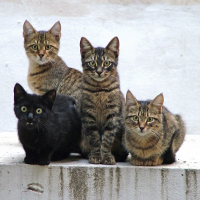 |
Chat de gouttière |
|
TranslationFrancis Vandersteen |
||
OriginAn Alley Cat or House Cat is a domestic cat with no specific breed. |
| The Chat de gouttière is the equivalent of the mongrel dog. |
| The name “Chat de gouttière” was used by Parisians to refer to stray cats roaming the rooftops. Cats like to roam on high ground. It's not uncommon for cats to wander, meet and even copulate in the gutters of houses. The kittens born of these encounters, whose fathers are unknown, are known as Chat de gouttière. By extension, any cat whose ancestry is not known with certainty is called an Alley Cat. The Chat de gouttière lives more or less independently of humans, but differs from the stray cat, which has returned to a completely wild state. The House Cat is often confused with the European shorthair, more commonly known as the European. In Europe, there are many Chat de gouttière cats whose morphology resembles that of the European shorthair for the uninitiated. This confusion is also found in other breeds, with a plain gray cat being improperly called a “Chartreux” or a colorpoint “Siamois”. The origins of the Chat de gouttière are those of the domestic cat in general. The origins of today's domestic cat are uncertain, but it is probably the result of cross-breeding between the Asian ornate cat, the African wild cat and the European wild cat. In France today, the vast majority of households with cats own Chat de gouttière. They are also authorized to take part in cat shows under certain conditions. They must be neutered (spayed or neutered) and registered with an association. There is no standard for the Chat de gouttière, as it is not a breed and therefore has no particular physical characteristics. All sizes, coats, colors and varieties are available. The European shorthair, like this cat show subject, is frequently confused with the Chat de gouttière. Nor is there any common trait among the Alley Cats. It is mainly influenced by living conditions, upbringing and weaning. All breeds are descended from Alley Cats, whose subjects have been reproduced with physical particularities (spontaneous genetic mutations, unusual physique, original color). Some more directly than others, as the new breeds were subsequently crossed with others, distancing them from the original type. The European, now known as the European shorthair, is systematically confused with the Chat de gouttière, as there are many other Chat de gouttière breeds in Europe with all the characteristics (morphology, character, health) of this breed. In everyday language, the term “European” has become a synonym for “Alley Cat” or “House Cat”. |






 English (United Kingdom)
English (United Kingdom)